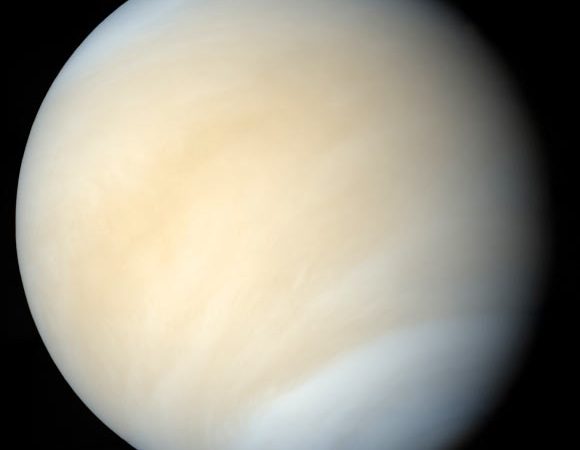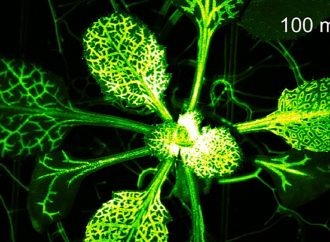In the search for alien life, astrobiologists have turned over all sorts of rocks. For example, Mars has geological features that suggest it once had subsurface liquid water. Scientists have also eyed Jupiter’s moons Europa, Ganymede and Callisto as well as Saturn’s Titan and Enceladus as possible havens for life in their subsurface oceans. Now, University of Wisconsin–Madison planetary researcher Sanjay Limaye and colleagues are dusting off an old idea that promises a new vista in the hunt for extraterrestrial life — the clouds of Venus. According to the team, the lower cloud layer of Venus (altitudes between 30 and 32 miles, or 47.5-50.5 km) is an exceptional target for exploration due to the favorable conditions for microbial life, including moderate pressures (one atm) and temperatures (140 degrees Fahrenheit, or 60 degrees Celsius), and the presence of sulfuric acid aerosols.
“Venus has had plenty of time to evolve life on its own. Some models suggest the planet once had a habitable climate with liquid water on its surface for as long as 2 billion years. That’s much longer than is believed to have occurred on Mars,” said Dr. Limaye, the lead author of the hypothesis paper, published in the journal Astrobiology.
“On Earth, terrestrial microorganisms are capable of being swept into the atmosphere, where they have been found alive at altitudes as high as 25 miles (41 km) by scientists using specially equipped balloons,” added co-author Dr. David Smith, a researcher with NASA’s Ames Research Center.
“On our planet, we know that life can thrive in very acidic conditions, can feed on carbon dioxide, and produce sulfuric acid,” said co-author Professor Rakesh Mogul, of California State Polytechnic University, Pomona.
“The cloudy, highly reflective and acidic atmosphere of Venus is composed mostly of carbon dioxide and water droplets containing sulfuric acid.”

A schematic representation summarizing the team’s ideas regarding the potential for microorganisms to survive in Venus’ lower clouds and contribute to the observed bulk spectra. In this scheme, the approximate altitude and temperatures are shown on the left axis, the approximate pressure on the right axis, while the surface topography represents an exaggerated perspective view of Venus. The cloud layer is depicted by a yellow-tinted hazy region between an altitude of 30 and 44 miles (47-72 km), where the varying opacities and thicknesses represent differences in mass loading. The black dots within the cloud layer depict the sulfuric acid aerosols with diameters ranging from 0.2 mm (which are found as high as 55 miles, or 90 km) to 2.5 mm and to as large as 36 mm (in smaller quantities) near the bottom of the cloud layer; aerosols below the cloud base have also been reported by the Venera probes. The hypothetical microbial contents of particles from the lower cloud layer are depicted in a magnified view using the dashed-line callout bubble, which shows differing possible microbial morphologies. These microorganisms may potentially survive by fixation of carbon dioxide through the phototrophic or chemolithotrophic oxidation of iron and sulfur compounds, and by a coupled iron-sulfur metabolism (depicted by the blue reaction scheme). The cloud-based microbial communities may remain afloat through gravity waves (red wavy line), which propagate up, and are triggered by westward ambient flows over the elevated topographies; gravity waves have been detected at the cloud tops in thermal infrared in the data from JAXA’s Akatsuki orbiter. Additionally, the convective activity of the lower cloud region may persist on the night side, thereby leading to opacity variations and differing thermal emissions through the cloud layer, as is observed in the near infrared in the data from Akatsuki and ESA’s Venus Express spacecraft. Consequently, the spectra of Venus may include contributions from the cloud-based microorganisms, as is depicted by the dashed-line callout originating from the magnified view of the particles; the inset spectral plot shows the albedo of Venus compiled from differing observations (red) and the sunlight absorption estimated by a singular measurement on the dayside (at one location), as calculated from the difference between the VIRA cloud model and the spectra from NASA’s MESSENGER spacecraft. The absorption of sunlight may actually extend to much longer wavelengths based on muted contrasts observed by Akatsuki, which is consistent with the albedo variation with wavelength. Image credit: Limaye et al, doi: 10.1089/ast.2017.1783.
The habitability of Venus’ clouds was first raised in 1967 by noted biophysicist Harold Morowitz and famed astronomer Carl Sagan.
Decades later, planetary scientists David Grinspoon, Mark Bullock and their colleagues expanded on the idea.
Supporting the notion that Venus’ atmosphere could be a plausible niche for life, a series of space probes to the planet launched between 1962 and 1978 showed that the temperature and pressure conditions in the lower and middle portions of the Venusian atmosphere would not preclude microbial life.
The surface conditions on the planet, however, are known to be inhospitable, with temperatures soaring above 860 degrees Fahrenheit (450 degrees Celsius).
“Venus shows some episodic dark, sulfuric rich patches, with contrasts up to 30–40% in UV, and muted in longer wavelengths. These patches persist for days, changing their shape and contrasts continuously and appear to be scale dependent,” Dr. Limaye said.
The particles that make up the dark patches have almost the same dimensions as some bacteria on Earth, although the instruments that have sampled Venus’ atmosphere to date are incapable of distinguishing between materials of an organic or inorganic nature.
“The patches could be something akin to the algae blooms that occur routinely in the lakes and oceans of Earth,” the researchers said.

The Venus Atmospheric Maneuverable Platform, which would fly like a plane and float like a blimp, could help explore the atmosphere of Venus. Image credit: Northrop Grumman.
In the hunt for extraterrestrial life, planetary atmospheres other than Earth’s remain largely unexplored.
“One possibility for sampling the clouds of Venus is on the drawing board — the Venus Atmospheric Maneuverable Platform (VAMP), a craft that flies like a plane but floats like a blimp and could stay aloft in the planet’s cloud layer for up to a year gathering data and samples,” Dr. Limaye said.
“Such a platform could include instruments like Raman Lidar, meteorological and chemical sensors, and spectrometers. It could also carry a type of microscope capable of identifying living microorganisms.”
“To really know, we need to go there and sample the clouds. Venus could be an exciting new chapter in astrobiology exploration,” Professor Mogul said.
Source: Sci News

































Leave a Comment
You must be logged in to post a comment.